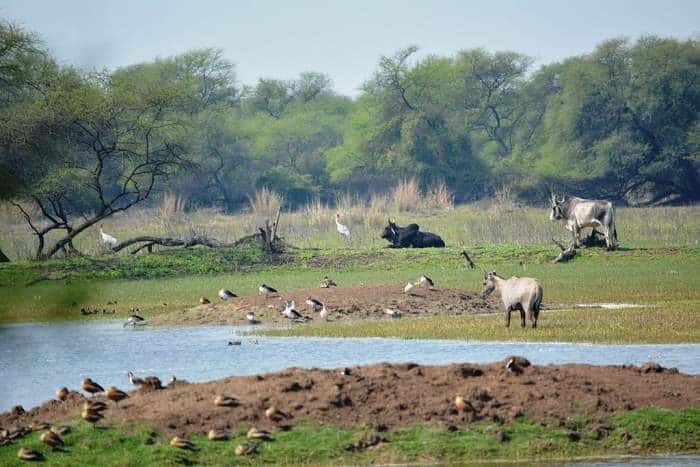Leaving the crowded cities of Ghana behind, travelers enter a world of untouched wilderness areas that are rich in fauna and flora. Ghana has 21 protected areas which include 7 national parks, 6 resource reserves, 2 wildlife sanctuaries, 1 strict nature reserve and 5 coastal wetlands.
It’s a country imbued with vast unspoilt wilderness areas that are waiting to be discovered. It’s not a traditional Big 5 safari destination but Ghana has a lot to offer wildlife and birding enthusiasts. We’ve compiled a list of the 7 most popular tourist destinations in Ghana for wildlife and nature lovers to give you an idea of the country’s beautiful natural regions.
Kakum National Park
Kakum National Park is located in the coastal environs of the Central Region of Ghana. The vast protected area is covered by a dense tropical forest that’s home to notable endangered species such as the Diana monkey, giant bongo, roan antelope, yellow-backed duiker and the African forest elephant.
There are 266 recorded bird species in Kakum National Park, of which 8 species are highly endangered. It’s also renowned for its rich abundance of butterflies. A highlight of a safari tour of Kakum National Park is the 350 meter Canopy Walkway which provides visitors with a bird’s-eye view of the forest’s extraordinary fauna and flora.
Mole National Park
Mole National Park is the largest national park in Ghana and provides the best safari experience in the country. Home to over 800 African elephants, it’s the one place in Ghana you can see these gentle giants up close in their natural environment. The national park is also a primary preserve for valuable antelope species including kob, defassa waterbuck, roan, hartebeest, oribi and the rare red and yellow-backed duiker.
You might like: visiting the Kruger National Park, South Africa.
The Lovi and Mole rivers flow through the national park, leaving behind the only natural drinking holes during the long dry season. Due to its lack of large predators, Mole National Park is popular for walking safaris. It’s also popular for birding safaris as it’s home to 344 recorded bird species, including the rare white-headed and palm-nut vultures, Abyssinian roller and violet turaco.
Bui National Park
Bui National Park is the third-largest national park in Ghana. It bisects the mighty Black Volta River which winds its way from Burkina Faso down to the White Volta in Ghana. It’s home to an abundance of river animals and water birds and is a most popular destination in Ghana for guided canoe safaris.
The national park is known for its huge pods of hippo that clog up the waterways. You’ll also find the endangered black and white colobus monkey in the dense riverine forests. Other features of Bui National Park are its cascading waterfalls, densely-forested mountains and stalactite caves that are inhabited by vast bat colonies.
Bia National Park
Bia National Park lies in the Western Region of Ghana and is home to rare varieties of mammals and bird species, including the highly vulnerable white-breasted guinea fowl. Covered over by an ancient rainforest, Bia has some of the tallest trees in West Africa.
On a typical safari tour of Bia National Park, you may see over 100 bird species a day as well as elephant, chimpanzees and antelope which includes Ghana’s major protected antelope. It’s also home to the newly-discovered species of lizard, Agama sylvanus.
Digya National Park
Digya National Park is a protected coastal reserve that lies on the shores of the massive Lake Volta. It’s home to a strong population of African elephant, an array of plains game and river creatures as well as over 200 recorded bird species.
A striking feature of Digya National Park is its sprawling coastal forests and dense savanna woodlands. Located on the shores of the great Lake Volta, the diversity of wildlife, birds and vegetation makes Digya a wonderful safari destination in Ghana.
Consider the Pilanesberg National Park in South Africa.
Kyabobo National Park
Kyabobo National Park is located on Ghana’s eastern border with Togo. It’s renowned for its outstanding fauna and flora, and home to 235 recorded bird species, 500 types of butterflies and an abundance of wildlife which includes elephants, buffalo, antelope and a variety of monkey species.
An important tree species in Kyabobo National Park is the endangered endemic Talbotiella gendtii which is found in the dry, semi-deciduous forest savannah. It’s a popular national park for guided nature walks due to its lack of large predators.
Nini Suhien National Park & Ankasa Resources Reserve
Nini Suhien National Park and Ankasa Resources Reserve are twin wildlife protected areas that are located in the wet evergreen forest area of the Western Region of Ghana.
Nini Suhien National Park is a smaller national park that is joined with the Ankasa Resources Reserve into a unified conservation area. Combined, the two wildlife reserves cover an area of about 500 square kilometers and, despite its relatively small size, the region has an incredibly rich biodiversity.
The Ankasa, Nini and Suhien rivers, rapids and cascading waterfalls are a feature of the wilderness area and provide valuable water resources to a host of animals and birds, including elephants, bongo, leopards, chimpanzee and the endangered Diana monkey. There are 263 recorded bird species in the protected forest area.
Visit Moafrikatours now for more information.













